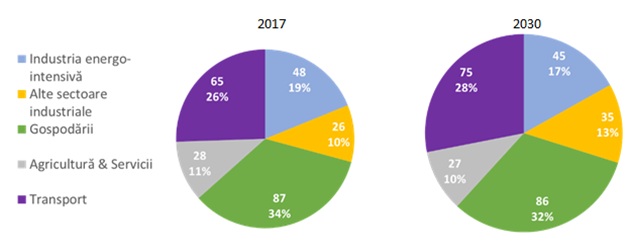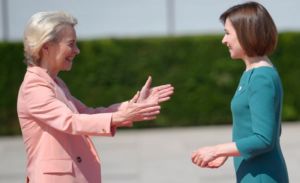 Romania’s most recent energy strategy estimates total investments in the field „between EUR 15 and EUR 30 billion for the period 2018-2030, with a central estimate of about EUR 20 billion”.
Romania’s most recent energy strategy estimates total investments in the field „between EUR 15 and EUR 30 billion for the period 2018-2030, with a central estimate of about EUR 20 billion”.
The strategy identifies „substantial investments that are necessary for the modernization and upgrading of the Romanian energy system over the next 15 years,” according to the project launched on Thursday for public debate by the Ministry of Energy.
The Energy Strategy has eight objectives:
- clean energy and energy efficiency;
- ensuring the access to electricity and heat for all consumers;
- protection of vulnerable consumer and reduction of energy poverty;
- competitive energy markets, the basis of a competitive economy;
- modernizing the energy governance system;
- increasing the quality of education in the energy field and continuous education of the human resource;
- Romania, regional energy security provider;
- increasing Romania’s energy contribution to regional and European markets by capitalizing on national primary energy resources.
To achieve these objectives, the ministry proposes four strategic investments of national interest, „fixed and binding benchmarks in strategic programming; all the other measures needed to meet the strategic objectives will be operationalized assuming the implementation of strategic investment projects of national interest.”
The four investments are:
- Completion of CNE Cernavoda Groups 3 and 4;
- Construction of the pump-fed hydroelectric power plant from Tarnita-Lapustesti;
- Construction of the 600 MW Group from Rovinari;
- Construction of Turnu-Magurele-Nicopole Hydro-technical Complex (Teleorman County)
First reactions
„The four <<strategic investments of national interest>> are not based on a cost optimization, they are only assumed at a political level without the support of an economic modelling.
They are assumed without any conditionality of economic efficiency, without detailing their impact on the market and the costs for the end energy consumer,” said expert Radu Dudau, director of Energy Policy Group.
„It is very good that, finally, the public debate on the new strategy begins,” said another expert, Razvan Nicolescu, former Energy Minister.
Indeed, the experts consulted by cursdeguvernare.ro have long revealed that each day when Romania’s energy policy „runs” without a coherent development and integration strategy is a new day of improvisation and turbulent waters.
„A strategy needs no context but implementation,” remarks Vasile Iuga, at the time senior advisor with PwC Romania, at the cursdeguvernare.ro conference „With the strategy on the table: Romania, in the European energy equation and the impact on the industry. Appropriate policies„.
Romania has not just „a huge potential for improving the energy efficiency” but also vulnerabilities, especially in the areas of governance, transparency and decision making,” said Razvan Nicolescu, and the current strategy does not address convincingly these challenges.
Uncertain financing
The chapter „Securing financial resources” of the new strategy invokes:
- „Using the private and/or public capital,
- European investment programs – structural funds and the one for strategic investment (which is expected to be extended by 2020 and supplemented),
- The programs of investment and development banks (EIB, EBRD, etc.)
- public-private partnerships, and investment schemes such as ESCOs for increasing buildings’ energy efficiency,
- budget revenues related to tenders for ETS system emissions permits, which it estimates to „billions of euros”
„The state can also define support mechanisms for certain types of investment, such as those for the revenue guarantee,” the document also says.
Other details – consumption, capacities
Romania’s gross energy consumption declined significantly after 1990, reaching 377 TWh in 2015, equivalent to about 19 MWh per capita, and the final energy consumption was 254 TWh, according to the Energy Strategy.
Gross energy consumption in 2030 is estimated to increase to 394 TWh and the final energy demand to 300 TWh. The consumption of energy resources as raw materials is to increase by 35%, while the consumption and losses related to the energy system will decrease by 4 TWh.
Evolution of energy demand by sectors of activity
*
- Energy-intensive industry
- Other industry sectors
- Households
- Agriculture & services
- Transport
*
The results of some modelling show an increase in energy production from nuclear sources from 17.4 TWh in 2030 to 23.2 TWh in 2035. An increase to 29 TWh will be recorded in total renewable sources, which represents a share of 37.6 % of the total primary energy sources that will form the energy mix in 2030.
The energy produced from coal will record 15.8TWh and will have a share of 20.6%. The electricity production from hydrocarbons will record an increase of 1.9%, about 14.5 TWh.
*
- Primary energy sources, as share in electricity production in 2017
- Nuclear
- Water
- Wind and solar
- Coal
- Oil
- Gas
- Biomass
- Primary energy sources, as share in electricity production in 2030
- Nuclear
- Water
- Wind and solar
- Coal
- Oil
- Gas
- Biomass
*











